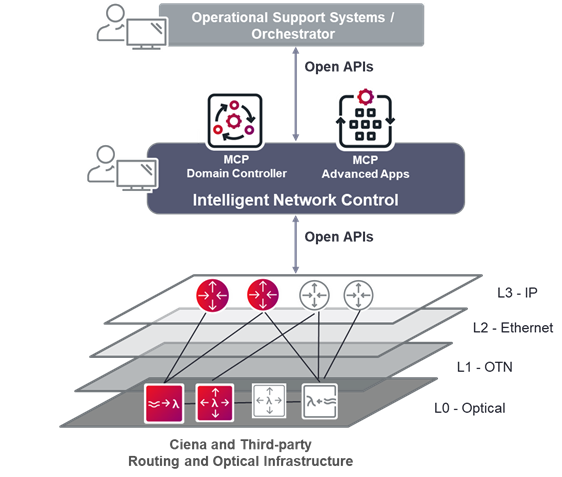Analyst Insights: Multi-layer SDN with enriched analytics helps operators improve customer experience
Justin van der Lande leads the Applications practice, which is part of Analysys Mason's Telecoms Software and Networks research stream. He specialises in business intelligence and analytics tools, which are used in all telecom business processes and systems. In addition, Justin provides technical expertise for Analysys Mason in consultancy and bespoke large-scale custom projects.
Network operators are striving to design and deploy cost-optimized IP/Optical converged architectures to support ever higher-bandwidth mobile, business, and residential connectivity services. Operations teams are challenged to follow suit by managing the multi-layer infrastructure in a cohesive way to shorten planning lead times for network design, expansions and simplify day-to-day operations. How can software-defined networking (SDN) controllers help?
First, let's take a deeper dive into some of the issues network operators are facing. SDN controllers support the delivery and management of the network paths that underpin customer services, but operators need to be aware of the availability of all the underlying network resource layers to achieve a high quality of service. Resources are typically managed in logical, independent network domains for IP, Ethernet, optical transport, and optical physical networks. Each domain is managed by its own network management system (NMS), which means that visibility and control of the network path are fragmented into a complex array of systems. This fragmentation is often stitched together through manual processes, which introduces delays in operations and monitoring and also introduces errors. All of which have a negative impact on the customer experience. But new introductions to the market are addressing these issues by controlling multiple technology layers from a single software system.
 Figure 1: Ciena’s MCP controller provides open interfaces for streamlined network operations across multiple layers. Source: Ciena
Figure 1: Ciena’s MCP controller provides open interfaces for streamlined network operations across multiple layers. Source: Ciena
The SDN controller solution for today’s demands needs to support full lifecycle management of network resources with the aim of delivering a high level of automation through closed-loop processes to allow key configuration, troubleshooting and optimization processes to be completed quickly and without the need for manual intervention. Ciena’s MCP (Manage, Control and Plan) controller, now known as Navigator Network Control Suite, is one such system that supports multiple technology layers and provides multi-vendor visibility, enabling integrated network operations.
Most operators want to automate their network operations to reduce opex – so what’s stopping them?
In a recent client survey conducted by Analysys Mason, more than 50% of the 150 operator participants reported that network automation is among their top-three strategic initiatives, and about 73% stated that reducing opex is the main driver for automating the network.
However, it is difficult for operators to achieve closed-loop network automation when using off-the-shelf solutions because each network operations team has its own unique set of requirements specific to its domain. Therefore, to achieve comprehensive network automation, the SDN controller must have a rich set of functionalities that is detailed enough to support the varied requirements and correlate data between layers to drive optimal network-wide decisions. The SDN controller must also be customisable through open interfaces in order to support each operator’s specific process automation requirements with back-end operational support systems (OSS).
An SDN controller typically needs to deliver lifecycle operational functions that include network planning, equipment deployment, service activation, service and network assurance, and optimisation in order to accomplish closed-loop automation. The key to making closed-loop automation possible is the use of analytics and machine learning (ML) insights, which ideally are embedded within the controller itself. ML enables high-quality data insights to be generated in a timely way to drive automated workflows, with minimal human interaction.
The key to making closed-loop automation possible is the use of analytics and machine learning (ML) insights, which ideally are embedded within the controller itself. ML enables high-quality data insights to be generated in a timely way to drive automated workflows, with minimal human interaction.
A simple and pragmatic stepwise approach will yield results
All automation does not need to be built at the same time. Instead of attempting to build a single comprehensive solution at the start, a stepwise approach in which new, automated, data-driven processes are implemented alongside existing manual or semi-automated processes means that each project creates value for operators on their path to full automation.
Integrated workflows across correlated network layers address the challenge otherwise associated with running multiple siloed domain controllers. As an example, with a multi-layer SDN controller, events and faults are correlated between layers and to impacted customer services, so that the root cause can be identified and resolved rapidly. Automation takes things a step further, by accelerating the pace at which repetitive operational tasks can be completed. In addition, the combination of analytics and automation enables proactive network management so that resiliency and performance can be continuously optimized.
Converged architectures require converged operations
The increasing adoption of converged architectures drives the need for converged multi-layer visibility, coordination and control. With the help of a multi-layer SDN controller solution, not only will the designed network deliver optimized capacity on day one, but day-to-day operations will proceed more quickly and efficiently, increasing the quality of experience for end customers.








